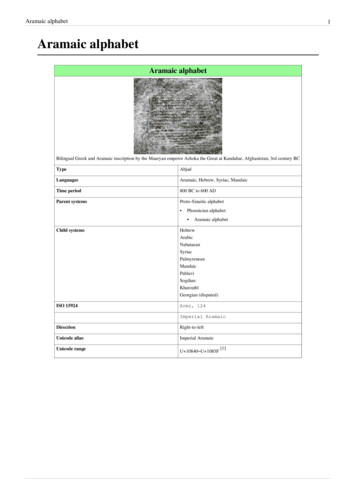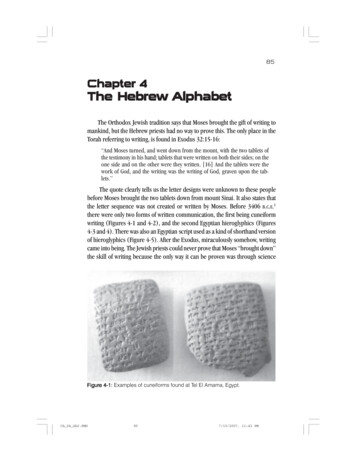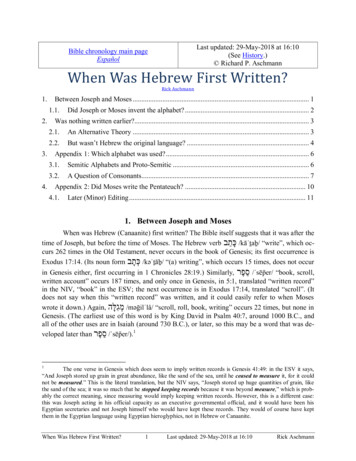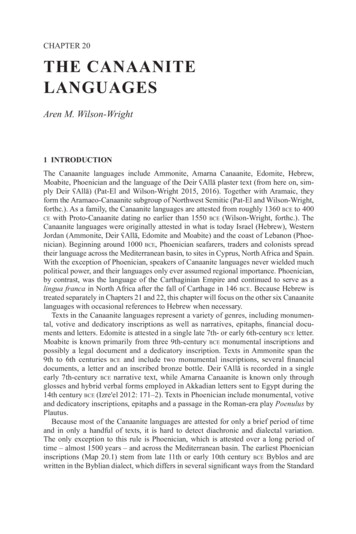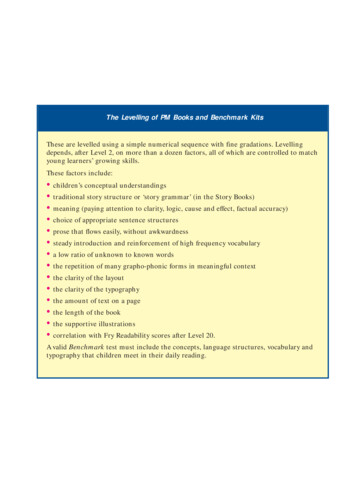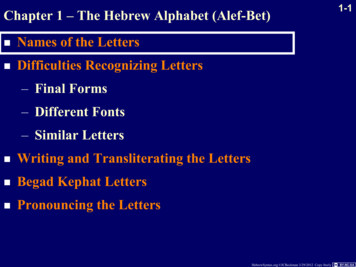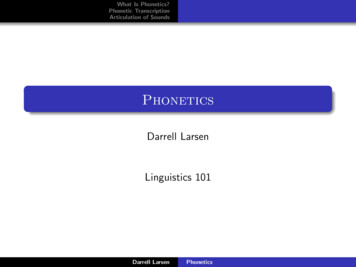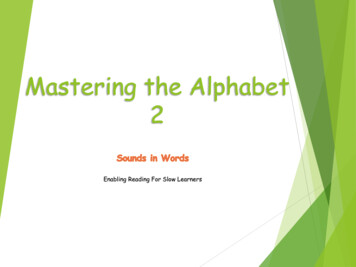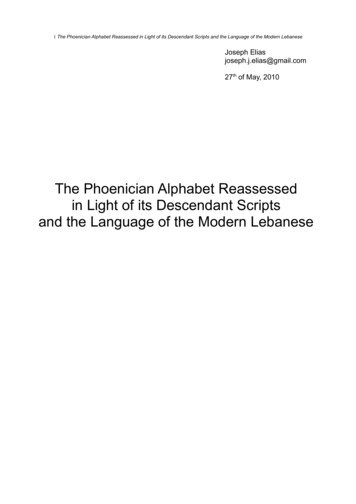
Transcription
1 The Phoenician Alphabet Reassessed in Light of its Descendant Scripts and the Language of the Modern LebaneseJoseph Eliasjoseph.j.elias@gmail.com27th of May, 2010The Phoenician Alphabet Reassessedin Light of its Descendant Scriptsand the Language of the Modern Lebanese
2 The Phoenician Alphabet Reassessed in Light of its Descendant Scripts and the Language of the Modern LebaneseDISCLAIMER: THE MOTIVATION BEHIND THIS WORK IS PURELY SCIENTIFIC.HENCE, ALL ALLEGATIONS IMPOSING THIS WORK OF PROMOTING A:POLITICAL, RELIGIOUS OR ETHNIC AGENDA WILL BE REPUDIATED.AbstractThe contemporary beliefs regarding the Phoenician alphabet are reviewed and challenged,in light of the characteristics found in the ancient alphabets of Phoenicia's neighbours andthe language of the modern Lebanese.
3 The Phoenician Alphabet Reassessed in Light of its Descendant Scripts and the Language of the Modern LebaneseIntroductionThe Phoenician alphabet, as it is understood today, is a 22 letter abjad with a one-to-oneletter to phoneme relationship [see Table 1].1 Credited for being the world's first alphabetand mother of all modern alphabets, it is believed to have been inspired by the olderhieroglyphics system of nearby Egypt and/or the syllabaries of Cyprus, Crete, and/or theByblos syllabary - to which the Phoenician alphabet appears to be a graphical subset of.2 3Table 1: The contemporary decipherment of the Phoenician alphabet.Letter Name Glyph Phonetic Value (in deS[sʕ]qophq[q]reshr[r]shins[ʃ]taut[t]1 F. Coulmas, The Blackwell Encyclopedia of Writing Systems, Blackwell Publishers Ltd, Oxford, 1999, pp. 401-403.2 S. Fischer, A History of Writing, Reaktion Books Ltd, London, 2003, pp. 121-122.3 J. Humphrey, Ancient Technology, Greenwood Publishing Group, Westport, 2006, p.86.
4 The Phoenician Alphabet Reassessed in Light of its Descendant Scripts and the Language of the Modern LebaneseDespite being successfully deciphered since the eighteenth century (A.D.), minimal effortshave been made to explore the motivation behind key characteristics of the script4 mainly: its apparent vowel less nature, the reason behind employing 22 letters and finally,a thorough analysis of the letters and their application in representing the vocal languageof the Phoenicians.MotivationContemporary thought claims the Phoenician alphabet exhibited 22 letters simply becausethe Phoenician language utilised no more than 22 phonemes. In this way, one Phoenicianletter corresponded to one phoneme found in the Phoenician language. Despite therebeing no solid proof of the Phoenician language only utilising 22 phonemes, this argumentalso appears to overlook the significance of numerology in ancient, north Semitic andneighbouring cultures. More specifically, the number 22 is the largest and arguably themost powerful of a special set of numbers known as the Master Numbers. 5 Twenty Two, formany numerologists, is a symbol of: pragmaticality/economy, leadership, success, anddiscipline6 - characteristics which can easily be associated with the alphabet whencompared to the less efficient pictographic and syllabic methods of writing. The Phoenicianalphabet, therefore, could have been purposely designed to utilise 22 letters so as toexpress the belief in the significance of the number 22 in Phoenician culture. The sameargument might also apply to Phoenicia's neighbours who also maintained a 22 letteralphabet after the Phoenicians, such as the: Hebrews, Assyrians, Nabataeans, Parthiansand the ancient Greeks of Crete [see Appendix A].7 8 9 The significance of the number 22 inancient, north Semitic culture is further emphasised by the 22 line inscription found on thePhoenician sarcophagus of King Eshmunazar II [see Figure 1] which would haveundoubtedly been precisely designed given the former status of the resting body inside.10Further still, the book of Revelations (also known as Apocalypse) is comprised of 22chapters which would appear as no coincidence given the (supposed) cryptic nature of thisbook.11 It is therefore, no accident that the alphabet of the Phoenicians and other nearbycultures exhibited 22 letters.12 Utilising 22 letters would have been the Phoenicianinventor's way of expressing his/her spiritual beliefs in light of his/her creation - the firstalphabet.1345678910R. Hetzron, The Semitic Languages, TJ International Ltd, Cornwall, 1997, p. 175.A. Oken, Numerology Demystified, The Crossing Freedom Press, California, 1996, p. 10.ibid., pp. 33-37.Humphrey, op. cit., p.86.A. Gaur, Literacy and the Politics of Writing, Intellect Books, Oregon, 2003, pp. 69-72.R. Woodard, Greek Writing from Knossos to Homer, Oxford University Press, New York, 1997, p. 141.G. Rawlinson, 'Chapter XIII – Phoenician Writing, Language and Literature' in History of Phoenicia, March 2006,Internet, htm#2HCH0013, (13 May 2010).11 J. Bell, S. Campbell, The Complete Idiots Guide to the Book of Revelations, Penguin Group Inc, USA, 2002, p.189.12 See Rawlinson, for more examples of Phoenician artifacts which exhibit the number twenty-two.13 It might just be a coincidence but Lebanon's day of independence is celebrated on the 22nd day of the 11th month (i.e.November 22). The number eleven, to numerologists, is the Master Number which precedes twenty-two and isarguably second in greatness – after twenty-two. Also, the original constitution of Lebanon required its governmentto be comprised of six Christian to five Muslim deputies. Thus, the total number of deputies in the (old) Lebanesegovernment was always a multiple of eleven. See: T. Collelo, 'World War II and Independence' in Lebanon: ACountry Study, 1987, Internet, http://countrystudies.us/lebanon/21.htm, (19 May 2010).
5 The Phoenician Alphabet Reassessed in Light of its Descendant Scripts and the Language of the Modern LebaneseSarcophage d'Eshmounazar II, UNESCO,http://portal.unesco.org/ci/en/ev.phpURL ID 16949&URL DO DO TOPIC&URL SECTION 201.htmlFigure 1: The sarcophagus of King Eshmunazar II,features a twenty-two line inscription.Confining the Phoenician alphabet to 22 letters opens the possibility of the inventorchoosing to sacrifice alphabetic ideality for spiritual expression.14 Thus, the simple and“ideal” method of representing one phoneme with one letter could have been purposelyrejected for a system where letters could exhibit a dual or greater polytypical nature - in thesame way the letter “c” in English, can represent (in IPA [see Appendix B]): [k] in “cat” or[s] in “city” or [ʃ] in “ocean” or [tʃ] in “cello”. Proving such phonetic ambiguity among thePhoenician letters when representing the Phoenician vernacular, however, would requireaccess to the vocal Phoenician language - which is assumedly extinct. 15 Despite thisapparently forgotten information, there may still be some credit in comparing scripted14 L. Grenoble, L. Whaley, Saving Languages: An Introduction to Language Revitalization, Cambridge UniversityPress, New York, 2006, p. 158.15 Hetzron, op. cit., p. 174.
6 The Phoenician Alphabet Reassessed in Light of its Descendant Scripts and the Language of the Modern LebanesePhoenician with the vernacular of the Maronite villages found high in the Lebanonmountain range. The motivation behind this comparison is drawn from the knownadamants portrayed by these mountain Phoenicians who were among the last in theRoman Empire to give up their brand of paganism and adopt Christianity. 16 17 Further, oncemade members of the universal church, this community refused to conform to theideologies of the Christian Orthodox churches - even after the later had become thespiritual status quo in the middle east.18 History has also shown that, as time progressed,not even the rife swords of the various conquering Islamic empires could perturb the faithof the Maronites of the Lebanon19 - not even after they were surrounded and then cut offfrom the rest of the world.20 Interestingly, as well, after being reunited with Rome during theHigh Middle Ages, it was found that the Maronites - unlike their other eastern Catholiccounterparts - had not fallen into heresy but had observed all aspects of their faith just asthey did before being separated from Rome.21 Finally, Lebanon's last official census(conducted in 1932) revealed that the Maronite community largely outnumbered all otherreligious communities in the newly formed nation of Lebanon.22 23 This observedinexorability, therefore, suggests that the Maronite community of the Lebanon mountainsmay be holding on to more than just their ancient faith - whether they are aware or not.Hence, therefore, the vernacular of the Maronites of the Lebanon mountains will beregarded as being closest to the vernacular of the Phoenicians and will thus, be comparedto scripted Phoenician so as to determine which letters of the Phoenician alphabet mayhave exhibited phonetic ambiguity.24HypothesisThe (vocal) Phoenician language featured more than 22 phonemes, despite thePhoenician alphabet featuring only 22 letters. In this way, Phoenician would have beenscripted more like modern English - which features more than 26 phonemes despite its 26letter (Romanised) alphabet.25Observation and AnalysisComparing scripted Phoenician with the vernacular of the Maronites of the Lebanonmountain range yielded several interesting patterns which are summarised, as follows:[N.B. The following comparisons were made by surveying Lebanese Maronites from theLebanon and then comparing their responses with the Phoenician word list given by16 DNA analysis, sponsored by National Geographic, has revealed the majority of modern Lebanese are descendants ofthe Phoenicians. See: R. Gore, 'Who Were the Phoenicians?' in National Geographic, October 2004, Internet, sia/lebanon/phoenicians-text/1, (13 May 2010).17 Rawlinson, op. cit., 'Chapter XIV – Political History, 8. Phoenicia Under the Romans (B.C. 65 – A.D. 650)'.18 J. Mahfouz, Short History of the Maronite Church, IMP. St Paul, Jounieh, 1986, p. 75.19 Prior to World War I, “the Lebanon” referred to the autonomous Lebanon Mountains which were predominantlyinhabited by Maronites and to a lesser extent, Druzes. This definition is slightly different to modern day “Lebanon”which comprises of the Lebanon Mountains as well as the Beqaa Valley and the adjacent Levantine coast. See D.Urquhart, The Lebanon: A History and a Diary, Thomas Cautley Newby, London, 1860.20 ibid., p. 90.21 ibid., p. 85.22 'Lebanon' in U.S. Department of State – Diplomacy in Action, 615.htm, (14 May 2010).23 K. Salibi, 'Lebanon' in Encyclopedia International, Grolier Incorporated, New York, 1971, p. 440.24 The people and therefore, the dialects of the Lebanese coast are likely to exhibit more foreign elements due to theirgreater interaction with foreigners. Hence, coastal dialects will be avoided in this comparison.25 A. Baker, Ship or Sheep, Cambridge University Press,Melbourne, 2006, p. iii.
7 The Phoenician Alphabet Reassessed in Light of its Descendant Scripts and the Language of the Modern LebaneseRawlinson and the online Phoenician dictionary found at: www.canaanite.org.] 26 27 28(Phoenician, like Hebrew and Arabic, is read from right to left.)The following results are presented in the format:{“English” – [Lebanese Maronite pronunciation in IPA] – scripted Phoenician}.1. letter 1, aleph (a), generally appears in place of any vowel, or a vowel preceded orproceeded with either another vowel or a glottal stop ([ʔ]) or a semi-vowel, e.g.“head” - [rɔːs] - sar,“request” - [sʌʔ-ʔɪl] - las,“earth; ground” - [ɑː-redʕ] - Sra,“one” - [weə-ħɪd] - dHa2. letter 2, beth (b), appears in the place of the phoneme [b], e.g.“bless” - [beə-rɪk] - krb3. letter 3, gamil (g), appears in the place of the phoneme [ʒ], e.g.“fee” - [ɑːʒ-redt] - trga4. letter 4, daleth (d), appears in the place of the phoneme [d] , e.g.“blood” - [dʌm] - md5. letter 5, he (h), appears in the place of the phoneme [h], e.g.“here” - [hɑːn] - nh6. letter 6, waw (w), appears in the place of the phonemes: [w], [ʊ] , e.g.“inside” - [ʒoʊ-weə] - wg,“and” - [ʊ] - w7. letter 7, zayin (z), appears in the place of the phonemes: [z], [d], e.g.“farm” - [mʌz-reəʕ] - orzm,“sacrifice” cf. “slaughter [an animal]” - [dɑː-bɪħ] - Hbz8. letter 8, heth (H), appears in the place of the phonemes: [ħ], [x], e.g.“go” - [rʊħ] - Hr,“kitchen” - [mʌdtʕ-beəx] - HbTm26 G. Rawlinson, 'Chapter XIII – Phoenician Writing, Language and Literature' in History of Phoenicia, Longmans,Green, and Co, London, 1889, pp. 380-384.27 M. Kassab, 'Online Phoenician Dictionary' in Canaanite.org, October 2009, Internet, http://canaanite.org/dictionary/index.php, (14 May 2010).28 Note, the names of the Phoenician letters are based on the educated guesses of Theodore Nöldeke. See: M. Everson,The Final Proposal for Encoding the Phoenician Script in the UCS, May 2004, Internet, http://std.dkuug.dk/jtc1/sc2/wg2/docs/n2746.pdf, (19 May 2010).
8 The Phoenician Alphabet Reassessed in Light of its Descendant Scripts and the Language of the Modern Lebanese9. letter 9, teth (T), appears in the place of the sound [dtʕ] , e.g.“belly” - [bʌdtʕ-dtʕen] - nTb10. letter 10, yodh (y), appears in the place of the sounds: [j], [ɪə], e.g.“day” - [jʌm] - my,“hand” - [ɪəd] - dy11. letter 11, kaph (k), appears in the place of the phoneme [k] , e.g.“every, all” - [kɪˈl] - lk12. letter 12, lamedh (l), appears in the place of the phoneme [l], e.g.“dog” - [kɑː-lɪˈb] - blk13. letter 13, mem (m), appears in the place of the phonemes: [m], [n] , e.g.“king” - [mɑː-lɪk] - klm,“forty” - [ər-bʕɪn] - mobra14. letter 14, nun (n), appears in the place of the phoneme [n], e.g.“good” - [ɪˈm-nɪħ] - Hnm15. letter 15, samekh (Z), appears in the place of the phonemes: [s], [zʕ] , e.g.“feel” - [ħɪˈs] - ZH,“memory; remember” - [zʕə-kɪr] - rkZ16. letter 16, ayin (o), appears in the place of the phonemes: [ʕ], [ɣ], e.g.“eye” - [ʕæn] - no,“dirt; dust” - [ɣʌ-bɪˈr] - rpo17. letter 17, pe (p), appears in the place of the phonemes: [b], [f] , e.g.“mosquito” - [bɑː-rɪˈɣ-ʃə] - sorp,“open” - [fɑː-dtɪħ] - Htp18. letter 18, tsade (S), appears in the place of the phonemes: [sʕ], [dʕ] , e.g.“onion” - [bʌsʕ-sʕɔːl] - lSb,“back” - [dʕɑː-hɪˈr] - rhS19. letter 19, qoph (q), appears in the place of the phoneme [ʔ], e.g.“bury; grave” - [ʔɑː-bɪˈr] - rbq
9 The Phoenician Alphabet Reassessed in Light of its Descendant Scripts and the Language of the Modern Lebanese20. letter 20, resh (r), appears in the place of the phonemes: [r], [l], e.g.“cattle” - [bʌʔ-ʔɔːr] - rqb,“root” - [ʃɪˈ-lɪˈʃ] - srs21. letter 21, shin (s), appears in the place of the phonemes: [s], [ʃ], and the sound[dt], e.g.“hear, listen” - [smeəʕ] - oms,“sun” - [ʃɑː-mɪˈs] - sms,“three” - [dtleə-dtə] - sls22. letter 22, tau (t), appears in the place of the sounds: [dt], [ndt], e.g.“died” - [meədt] - tm,“daughter” - [bɪˈndt] - tb23. no letter, this typically occurs when an initial or final vowel is pronounced but is notscripted, e.g.“heart” - [ɑː-lɪˈb] - bl,“I; me” - [ə-neə] - naThese results are summarised in Table 2.
10 The Phoenician Alphabet Reassessed in Light of its Descendant Scripts and the Language of the Modern LebaneseTable 2: A summary of the decipherment obtainedby comparing scripted Phoenician with thevernacular of the Maronites, living in the LebanonMountains.Letter Name Glyph Phonetic Value (in IPA)alephaAny vowel or combination of vowelbethb[b]gamilg[ʒ]dalethd[d]heh[h]waww[w], [ʊ]zayinz[z], [d]hethH[ħ], [x]tethT[dtʕ]yodhy[j], [ɪə]kaphk[k]*lamedhl[l]memm[m], [n]nunn[n]samekhZ[s], [zʕ]ayino[ʕ], [ɣ]pep[b]ϯ, [f]tsadeS[sʕ], [dʕ]qophq[ʔ]reshr[r], [l]shins[s], [ʃ], [dt]taut[dt], [ndt]and another vowel or glottal stop.* and possibly [g]ϯ where [b] is probably Arabised [p]. Also, [v] might have also been represented by p [see Appendix D].These results were used to make the following analysis.Letters: 2, 3, 4, 5, 9, 11,12, and 14 (beth, gamil, daleth, he, teth, kaph, lamedh, and nun,respectively), appear in the same place as their phonetic equal in spoken Lebanese - if
11 The Phoenician Alphabet Reassessed in Light of its Descendant Scripts and the Language of the Modern Lebaneseone considers the traditional decipherment of the Phoenician alphabet. 29 The remainingcharacters also give credit to the traditional decipherment, however, the observed patterns(above) suggest a slightly more sophisticated letter to phoneme relationship. Theseapparent relationships will be addressed in the following paragraphs.Firstly, the duplicity exhibited by characters: 8, 16, and 18 (heth, ayin, tsade, respectively)can be clarified by taking a closer look at the Arabic alphabet – believed to be thesuccessor of the Phoenician alphabet via Aramaic and Nabataean intermediaries. Thus, acomparison between heth (H) and its Arabic equivalent, ħa' ( )ح , show that both lettersstand in the place of the phoneme [ħ]. However, by simply adding a diacritic (i'jam) to theħa', the resultant letter - xa' ( )خ - becomes a representative of the phoneme [x]. Thus, byignoring the additional diacritic, it becomes clear that the letter form “ ”ح stands as arepresentative for either [ħ] or [x]. This observation in Arabic is analogous to thecomparison (above) between scripted Phoenician and the Lebanese vernacular and thus,suggests that heth (H) always did represent both [ħ] and [x] it is just that thePhoenicians preferred not to use diacritics – just like “g” in English “gate” ([g]) or “general”([dʒ]). Further, of all the possible designs xa' ( )خ could have taken, it seems more thancoincidental for it to simply appear as a ħa' ( )ح with a diacritic ( )خ . Surely, there must besome motivation behind this convention and based on the link between spoken Lebaneseand scripted Phoenician, it does seem very likely that the Arabs had always known aboutthe phonetic duplicity of heth (or at least its Nabataean descendant) but finally decided todistinguish between its two phonemes by utilising a diacritic. Therefore, it is very possiblethat heth always did represent the two phonemes [ħ] and [x]. The same arguments canalso be applied to the Phoenician letter ayin (o) representing [ʕ] and [ɣ] in the same waythat adding a diacritic to Arabic ayin ( [ )ع ʕ] causes it to become ghayn ( [ )غ ɣ] whilstPhoenician tsade (S) can be [sʕ] or [dʕ] just like how Arabic tsade ( [ )ص sʕ] becomes d'ad[dʕ] once a diacritic is added ( )ض .In light of this suspected duplicity, it is worth noting that diacritic-less Arabic text has beenfound scripted along the walls of archaic mountain dwellings within the Lebanon [seeFigure 2].30 Such observations suggest the existence of an era in which Arabic lettersexhibited phonetic ambiguity and thus, suggest that phonetic ambiguity may have beeninherited from ancestral scripts. The disappearance of such ambiguities would haveeventuated from the addition of consonantal diacritics.3129 Letter 11, kaph, may have also stood for the phoneme [g]. This suggestion is motivated by the Lebanese word for“hookah” pronounced [ər-gɪ-lɑː] and spelt (in Arabic letters) اركيلة , and the Lebanese word for “marbles” (thetoy) which is pronounced [gɪˈl-lɑː] and is spelt (in Arabic letters) كلة . Using the Arabic kaph to represent [g] is nottypical in other nations around the Middle East. In Egypt, for example, [g] is typically represented by the Arabicletter jim ( )ج whereas in Iraq, the letter qof ( )ق is used. See: D. Cowan, Modern Literary Arabic, CambridgeUniversity Press, Melbourne, 1978, pp. 3-4.30 G. Hayek, The Qadisha Valley From the Depths. to the Peaks, Annahar Publishing House, 2008, p. 83.31 The appearance of early Arabic text in the Lebanon does not serve as sufficient proof of the Lebanese speakingArabic. Such an argument would be as naïve as saying “Ottoman Turks spoke Arabic because it was their officialscript unlike modern Turks, who speak a dialect of Latin because now they use a Romanised alphabet.” Anyalphabet can be used to record any language so long as conventions and/or standardisations' are realised.
12 The Phoenician Alphabet Reassessed in Light of its Descendant Scripts and the Language of the Modern LebaneseG. Hayek, The Qadisha Valley From the Depths. to the Peaks, Annahar Publishing House, 2008, p. 83.Figure 2: Arabic text bearing minimal or no diacritics. This specimen was found in a cave dwelling inthe Qadisha Valley, Lebanon.Character 21, shin (s), exhibits triplicity such that it appears in place of the phonemes[s], [ʃ], and (apparently for the cardinal numbers) [dt]. Like the previously describedcharacters, it appears logical enough for Arabic to have inherited the ambiguity between[s] and [ʃ] from the Phoenician shin.32 Diacritics are again, however, employed in Arabic todistinguish between the phonemes [s] and [ʃ]. The modern Arabic alphabet also opens thepossibility that, the Phoenician shin could have also represented [dt] by implicitly showingthat two letters have been omitted from the modern Arabic alphabet - between sin ( )س andshin ( )ش . To elaborate, Arabic sin peculiarly progresses to shin by the sudden addition ofthree diacritics. This is in contrast to the rest of the Arabic alphabet where progressions tothe next letter are generally made by the addition of one diacritic (at a time) [see Figure 3].Thus, it is possible that one of the letters omitted between Arabic's sin and shin could havestood for [dt] and this could have been inherited from Phoenician (via Hebrew and/orNabataean) but then eventually omitted perhaps due to the application of the Arabic letterta' ( )ت with other Arabic grammatical conventions.33 It may seem strange at first, for the32 This particular ambiguity may be the reason why, the word “tree” is typically pronounced [səʒ-rɔː] in the Maronitevillages of the mountains but then pronounced [ʃəʒ-rɑː] in and around Beirut. Alternatively, perhaps this differencein pronunciation was the motivation for representing [s] and [ʃ] with the same letter.33 Another interesting and possibly related comparison between the vocabulary of the Lebanese vernacular and modernliterary Arabic is that, the letter tha' (phonetically [θ]) is never pronounced [θ] but instead, [s] or [dt]. Also, in theLebanese Arabic alphabet, tha' is actually named “sea” and represents the phoneme [s] - by default.
13 The Phoenician Alphabet Reassessed in Light of its Descendant Scripts and the Language of the Modern LebanesePhoenicians to represent [dt] with shin when character 22 (tau) apparently already did thesame job. However, if one considers the grammatical structure of scripted Phoenician andthen of spoken Lebanese (if Lebanese can be used as a decent substitute for Phoenician),one will realise the emergence of very ambiguous homographs. As an example, thenumber “three” in Lebanese, is (more or less) pronounced [dtleə-dtə] whilst “one third” is(more or less) pronounced [dtɪˈ-lɪˈdt]. If one is to represent both these numbers bytypically scripting only consonants, as is done in Phoenician, then the result for bothnumbers will be (in Roman) “dtldt”. Obviously, such an ambiguity between “three” and “athird” could have catastrophic results in fields which rely heavily on numbers, such asengineering. Thus, a convention would have been necessary to avoid such homographs,hence, the application of shin for [dt] when writing the cardinal numbers whilst (probably)reserving letter 22 (tau) for the fractional equivalents. Therefore, the employment of shin toalso represent [dt] may have been seen as the solution to avoiding certain homographs.34Figure 3: Letters (in red) which appear to be missing from the Modern Standard Arabic alphabet.The duplicity regarding letters 6 and 10 (waw and yodh, respectively), appears to beanalogous to the Arabic waw ( )و and ya' ( )ي , respectively. Thus, it is very easy to argue34 Although it seems that this only applies to the cardinal numbers, it might also be applicable to other cases and maythus explain why some Lebanese today say [sɪˈdt-dtə] for “grand mother” whilst others say [dteɪ -dteə].
14 The Phoenician Alphabet Reassessed in Light of its Descendant Scripts and the Language of the Modern Lebanesethat the Arab equivalents inherited their duplicity from their Phoenician ancestor whosewaw also represented the phonemes [w] and [ʊ] whilst yodh also represented thephonemes [j] and [ɪə].Letter 1, aleph, appears as: a vowel, or a vowel combined with another vowel or semivowel or a glottal stop. This is contrary to popular belief which suggests the aleph stoodonly for a glottal stop. To justify the observations made, one needs to only listen to spokenLebanese to realise the exact pronunciation of certain words depends on how the word isused. The word “eat”, for example, is spelt lka in Phoenician but is typically pronounced(in Lebanese) [jeə-kɔːl] in [bɪ-jeə-kɔːl] - “he eats” - but is then pronounced [ʔeə-kɔːl] in[ɪˈb-ʔeə-kɔːl] - “I eat”. The change from the third person to the first person, therefore, haslead to a slight change in pronunciation - a change undoubtedly noticed by the creator ofthe alphabet who would have thus, included aleph so as to stand for all the variouspronunciations of a given vowel from a particular word. Aleph, therefore, may haveoriginally stood for vowels whose pronunciation was influenced by grammatical factorssuch as the person.In further opposition to popular thought, it would seem sensible to suggest the aleph wouldhave originally sounded very much or the same as what would become the Greek alpha(Α, α) - that is, a vowel. Further, if one considers the Arabic rendition of the Lebanese ا vernaculars, alif ( , aleph's Arab equivalent) serves as a vowel and only acts as a vowel ء أ إ and glottal stop when written with a hamza ( ) above ( ) or below it ( ).35 The addition ofthe hamza in Arabic, therefore, may have been devised so as to distinguish whether alifshould be read as a vowel or a glottal stop and vowel. Thus, it may be fair to argue that thealeph (a) always did represent vowels in general.Letter 7, zayin, appears in place of the phoneme [z] (as popular thought suggests) butalso for the phoneme [d]. The later case may seem rather strange, especially since theletter daleth (d) already appears to adequately serve the phoneme [d]. However, thosewho are familiar with spoken Lebanese today and Modern Standard Arabic (MSA) mighthave also noticed that there does appear to be some interesting exchanges betweenequivalent words with [d] and [z] and their emphatic versions. For example, the verb“clean” is pronounced [nɑː-dɪf] in Lebanese but is pronounced [næ-zʕiːf] ( )نظيف in MSAwhilst the noun “back” is pronounced [dʕɑː-hɪˈr] in Lebanese but [zʕæ-hr] ( )ظهر inMSA.36 It might be possible that the Arabs or those before them, took the Phoenicianwords but chose to pronounce them by considering only one possible pronunciation. Ifzayin (z) did in fact, represent both [z] and [d], one may wonder what motivation couldbe behind such ambiguity. Perhaps it may have been to avoid certain homographs forreasons similar to those discussed for shin.3735 Cowan, op. cit., p. 3.36 F. Mansouri, Pocket Arabic Dictionary, Periplus Editions, Singapore, 2004, pp. 48, 53.37 Interestingly, the letter “dhal” ( )ذ in Modern Standard Arabic is named “za” in the Lebanese Arabic alphabet and istypically read as [z] (by default) or [d] but never [ð]. This is interesting because one only needs to remove thediacritic above dhal to make it dal ( )د which thus, emphasises the relationship between [d] and [z] when scriptingthe Lebanese vernacular.
15 The Phoenician Alphabet Reassessed in Light of its Descendant Scripts and the Language of the Modern LebaneseLetter 13, mem (m), appears in place of the phonemes [m] and [n] when juxtaposed withthe equivalent Lebanese. Interestingly, however, mem only seems to appear in place ofthe [n] when [n] is present at the end of a cardinal number. For example, the number fortyis pronounced (more or less) [ər-bʕɪn] in Lebanese where as in Phoenician it is speltmobra. Perhaps, therefore, mem typically represented [m] but also represented [n]when [n] was the final sound of a cardinal number. Again, the possible motivation behindsuch a convention may be related to avoiding certain homographs.Letter 15, samekh (Z), was a relatively difficult character to decipher because of therelative few specimens discovered, only about two or three were comparable to anequivalent Lebanese word. Traditionally, this character is believed to stand for thephoneme [s] which seems fitting when one compares the Lebanese word [ħɪˈs] with thePhoenician ZH - which both mean “feel”. However, samekh also appears to take theplace of [zʕ] in the word “remember” which is pronounced [zʕɑː-kɪr] in Lebanese and isscripted rkZ, in Phoenician. More comparable specimens will be required before a fairdecipherment of samekh can be made. Shin (s) already appears to adequatelyrepresent the phoneme [s], however, samekh may have also been used for this purposefor similar reasons given earlier - regarding homographs. Further, it would seem plausiblefor samekh to represent [zʕ], especially if one considers that the Phoenicians may havealso wanted a letter to represent emphatic [z] (that is, [zʕ]), in the same way that tsaderepresented emphatic [s] and [d] ([sʕ] and [dʕ], respectively) whilst teth representedemphatic [t] (that is, [tʕ]).Letter 17, pe (p), appears in place of the phonemes [b] and [f]. Traditional decipheringsuggests pe represented [p] which is plausible given its alphabetic position whencompared to the alphabets used in nearby cultures. Further, it would seem logical for thePhoenicians to possess the phoneme [p] just like their neighbouring communities acrossthe Mediterranea
3 The Phoenician Alphabet Reassessed in Light of its Descendant Scripts and the Language of the Modern Lebanese Introduction The Phoenician alphabet, as it is understood today, is a 22 letter abjad with a one-to-one letter to phoneme relationship [see Table 1].1 Credited for being the world's first alphabet and mother of all modern alphabets, it is believed to have been inspired by the older


